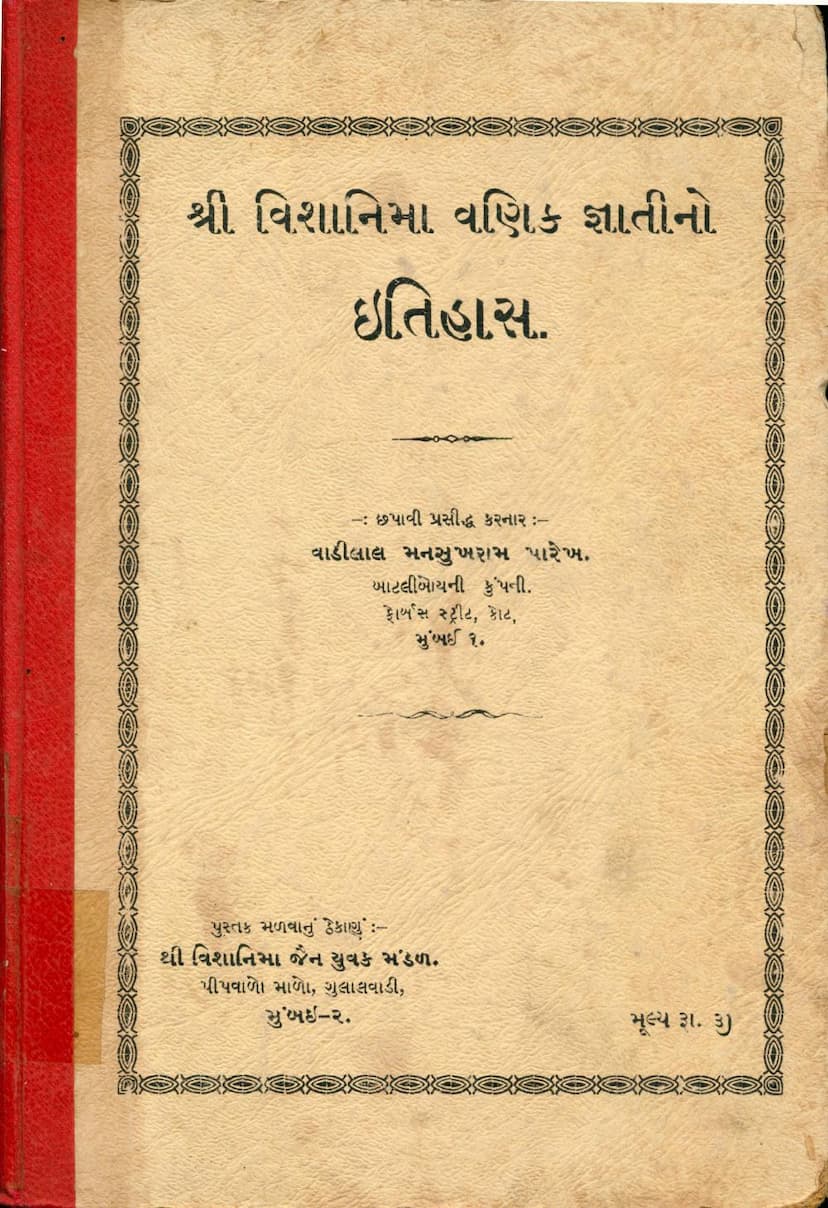Vishanima Vanik Gnatino Itihas
Added to library: September 2, 2025

Summary
Here's a comprehensive summary of the Jain text "Vishanima Vanik Gnatino Itihas" by Mahasukhram Prannath Shrotriya, based on the provided pages:
Book Title: Vishanima Vanik Gnatino Itihas (History of the Vishanima Vanik Community) Author: Mahasukhram Prannath Shrotriya Publisher: Vadilal Mansukhram Parekh, Mumbai
Overall Scope and Purpose:
This book is a historical account of the Vishanima Vanik community, a merchant (Vanik) sect within Jainism. The author, Mahasukhram Prannath Shrotriya, undertakes the significant task of compiling this history, aiming to provide a comprehensive understanding of the community's origins, traditions, social structure, religious practices, and historical journey. The work is dedicated to preserving the legacy and identity of the Vishanima Vanik community, particularly focusing on their connection to Kapadvanj and their lineage.
Key Themes and Content Areas:
-
Genealogy and Lineage: A significant portion of the book is dedicated to tracing the lineage and family trees of prominent individuals and families within the Vishanima Vanik community, especially those residing in Kapadvanj. This includes detailing their family gurus and relationships, offering a glimpse into the community's social fabric and historical connections.
-
Historical Origins and Evolution: The text delves into the origins of the community, attempting to connect them to ancient Indian social structures like the Chaturvarna system and the concept of castes. It explores the migration patterns and settlement of the community, particularly highlighting their presence in places like Kapadvanj, Modasa, and Shamalaji. The book also discusses the potential evolution of their name from "Niyama Vanijya" to "Nima Vanik," and the historical context of their commercial activities.
-
Religious and Social Practices: The book touches upon the religious and social customs that define the Vishanima Vanik community. This includes mentions of their caste system, Gotras, clan deities (Kuldevi), and the importance of adhering to traditional practices and rituals. It also discusses the influence of Jainism and Vaishnavism within the community, noting that while many have transitioned to Vaishnavism, their core traditions remain.
-
The Role of Shamalaji and Kapadvanj: Shamalaji, with its Lord Gadadhar (Shamalaji) deity, holds a significant place as the presumed origin and ancestral deity for the community. The text describes the temple and its historical significance. Kapadvanj is presented as a major settlement and a significant center for the community, with detailed historical accounts of its development and the community's contribution to its prosperity.
-
Community Organization and Efforts: The book chronicles the community's efforts towards self-organization and progress. It highlights the establishment of various committees and the holding of conferences (like the Indore and Godhra conventions) to foster unity, discuss social reforms, and address challenges. The text also emphasizes the importance of education and efforts made towards establishing educational institutions for the community.
-
Notable Personalities and Contributions: The book mentions several key individuals who played significant roles in the community's history and development. This includes the editor Mahasukhram Prannath Shrotriya, the publisher Vadilal Mansukhram Parekh, and contributors like Govindlalji Shastry. It also highlights the philanthropic activities of prominent families, such as the Parekh family and the contribution of individuals like Seth Hirjibhai Ambadas, Seth Manibhai Shamlal, and Seth Chimmanlal Dahyabhai.
-
Social Reforms and Modernization: The text reflects the community's engagement with modern societal changes. It discusses the need for adapting traditions to the times, promoting education, and fostering a sense of unity across different branches of the community (like the Dasha and Visha Nima Vaniks). The efforts to overcome internal divisions and promote inter-communal harmony are also mentioned.
-
Detailed Account of Gotras: Chapter 8 is dedicated to explaining the meaning and origin of the various Gotras (clan names) within the community. It aims to clarify the etymology of these names and their historical significance, linking them to ancient Indian traditions and the Chaturvarna system.
-
Population Data and Distribution: Chapter 10 provides an attempt to detail the population distribution of the Dasha and Visha Nima Vanik communities across various regions of India, including statistics on the number of households and individuals.
-
Legal and Structural Framework: The latter part of the book includes the draft constitution and proceedings of the community's conferences, outlining the organizational structure, objectives, and rules for their collective endeavors. This demonstrates a formal effort to govern and guide the community's activities.
Publishing Details:
- Printed by: Mohanlal Tribhovanadas Modi, Mumbai.
- First Edition: 1000 copies.
- Printing Press: General Commercial Printary, Mumbai.
- Price: Rs. 3/-
Overall Significance:
"Vishanima Vanik Gnatino Itihas" serves as a valuable historical document for the Vishanima Vanik community. It not only preserves their history and traditions but also reflects their aspirations for social cohesion, educational advancement, and a strong collective identity in a changing world. The detailed genealogical and demographic information, coupled with historical narratives and religious aspects, makes it a significant resource for understanding the community's heritage. The effort to connect their origins to ancient Indian society and the detailed explanation of Gotras further underscore the depth of the research. The inclusion of conference proceedings and constitutional drafts highlights the community's proactive approach to self-governance and future development.